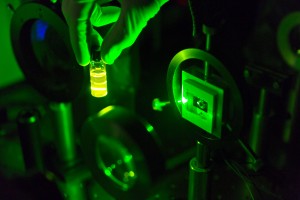Feb 10 2016
Researchers in Valencia have studied the interaction of two materials, halide perovskite and quantum dots, revealing enormous potential for the development of advanced LEDs and more efficient solar cells.

Researchers from the Universitat Jaume I (James I University, UJI) and the Universitat de València (University of Valencia, UV) have quantified the “exciplex state” resulting from the coupling of halide perovskites and colloidal quantum dots. Both known separately for their optoelectronic properties, when brought together these materials yield much longer wavelengths than can be achieved by either material alone, plus easy tuning properties that together have the potential to usher in important changes in LED and solar technologies.
Perovskite materials are the rising stars of the photovoltaic industry. They are cheap to produce, simple to manufacture and very, very efficient. Better yet, they are relatively new to the scene and there is still much potential to explore for even more efficient solar cells. They are also used in LED technology. Quantum dots (QDs), for their part, are a family of semiconductor materials with very interesting light-emitting properties, including the ability to tune what wavelengths light is emitted at. They are also very useful in both LEDs and solar cells.
The result of bringing the two materials together is a new exciplex state where light can be emitted at much longer wavelengths, reaching well into the infrared spectrum, while also allowing control over its emission colour via applied voltage. Each material —the perovskite, the QDs and the new exciplex state— emits light at a different colour, each of which can be weighted within the overall light emission to pick out the desired colour.
This means LEDs can be designed which can emit light over both the visible and infrared spectrums at the same time, which would have applications in the field of telecommunications.
Furthermore, working on the basis of the reciprocity principle, this new state will potentially lead to the development of solar cells that can transform more of the Sun’s light into electrical energy. Currently solar cells can only transform light emitted over a relatively narrow band of wavelengths. But if it is possible to produce light at longer wavelengths via an electrical input, then it is theoretically possible to obtain electrical energy by absorbing light with these longer wavelengths, thereby increasing the efficiency of solar cells.
The team, led by Iván Mora Seró (UJI) and Juan P. Martínez Pastor (UV), is currently testing this theory.
The full article can be consulted here, http://advances.sciencemag.org/content/2/1/e1501104 in Science Advances.